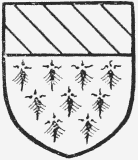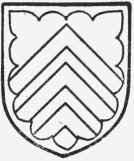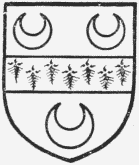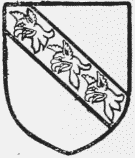A History of the County of Worcester: Volume 3. Originally published by Victoria County History, London, 1913.
This free content was digitised by double rekeying. All rights reserved.
'Parishes: Croome d'Abitot', in A History of the County of Worcester: Volume 3(London, 1913), British History Online https://prod.british-history.ac.uk/vch/worcs/vol3/pp313-316 [accessed 23 April 2025].
'Parishes: Croome d'Abitot', in A History of the County of Worcester: Volume 3(London, 1913), British History Online, accessed April 23, 2025, https://prod.british-history.ac.uk/vch/worcs/vol3/pp313-316.
"Parishes: Croome d'Abitot". A History of the County of Worcester: Volume 3. (London, 1913), British History Online. Web. 23 April 2025. https://prod.british-history.ac.uk/vch/worcs/vol3/pp313-316.
In this section
CROOME D'ABITÔT
Cromma (x cent.); Crumbe (xi cent.); Crumba, Crombe Abetot, Crombe Osbert (xiii cent.); Croumbe, Crombe Osbern (xiv cent.); Croom Dabitot, Abytotescrombe (xv cent.); Abbotts Crome (xvii cent.).
This parish, covering an area of 1,178 acres, lies to the south of the county, 8 miles south-east from Worcester. The land rises towards the north and west; at the south-east of the parish it is only 51 ft., rising to over 100 ft. above the ordnance datum to the north of Croome Court, on the Pershore road. To the west of this road, on the border of the park, is the new church of St. James, built in 1763, the site of the old church near Croome Court being now only marked by two trees. The high road from Severn Stoke to Defford passes along the north side of the park, and on it is the hamlet of High Green.
The village of Croome D'Abitôt, which lies on the northern borders of the park of Croome Court, the residence of the Earl of Coventry, is altogether devoid of architectural interest. Croome Court itself is a fine stone mansion, erected about 1750. The plan is of the dignified and symmetrical character which was then in favour, consisting of a central block two stories in height, with four three-storied pavilions at the angles, crowned by pyramidal slated roofs. The whole is elevated upon a basement, and the principal entrance, in the centre of the north front, is approached by a balustraded flight of stone steps. In the centre of the south or garden front is a tetrastyle portico of the Ionic order. The banqueting-hall, which occupies the whole of the western front, is a beautiful example of the Adam style. The walls are painted in monochrome, in imitation of sculpture, and the ceiling is richly coffered. The chimney-piece, of white marble, with caryatid figures, is an extremely good and characteristic piece of design. The yellow drawing room and saloon are also very perfect examples of the same style. The library, which occupies the ground floor of the south-east pavilion, still retains its specially designed book-cases. The staircase is at this end, and occupies the centre of the east front. The decoration of these rooms seems to have been undertaken some years subsequently to the first erection of the house. The panelling of the green dining room and billiard room on either side of the entrance hall is of the earlier date. The park was laid out by 'Capability' Brown, and, it must be confessed, with very successful results. The 'properties' include an artificial river, several temples and a ruined castle at Dunstall, half a mile away. The park is thickly wooded and abounds with deer. There is an arboretum which includes many rare trees and shrubs.
The soil in this parish is loam and clay with subsoil of Lower Lias; 832¾ acres are laid down as permanent grass, 169½ acres are arable land, (fn. 1) the chief crops being wheat, barley and beans, and 54¾ acres are covered by woods and plantations.
MANOR
The church of Worcester had evidently acquired land in CROOME D'ABITOT before 969, when Bishop Oswald leased land there for three lives to the thegn Cynelm. (fn. 2) This land formed part of the bishop's manor of Ripple in 1086, (fn. 3) and was still said to be held of that manor in 1640. (fn. 4) In 1471 land in Croome D'Abitôt and Kerswell was said to be held of the Bishop of Worcester as of his manor of Kempsey, (fn. 5) but it is doubtful whether the manor of Croome D'Abitôt was ever so held.
In the reign of Edward the Confessor Croome D'Abitôt was held by Sirof. On the death of the latter the bishop gave his daughter with this land to a certain knight on condition that he should support her mother and render service to the bishop. (fn. 6) Siward was holding the manor in 1086, (fn. 7) but early in the 12th century the estate was held by Walter de Beauchamp. (fn. 8) His interest in the manor passed with the barony of Elmley Castle until 1530, when it is mentioned for the last time. (fn. 9)
Under the lords of Elmley the manor was held by the family of D'Abitot. Robert D'Abitot is mentioned in the Pipe Roll for Worcestershire in 1165–6, (fn. 10) and was probably the Robert whose heir was holding 5 hides in Croome D'Abitôt (Moldecrombe) of William Beauchamp about 1182. (fn. 11) This heir was, perhaps, Osbert, who was living in 1172. (fn. 12) He or a descendant of the same name was holding the manor about the middle of the 13th century, (fn. 13) and Sir William D'Abitot was probably the owner in 1254, when an agreement was made with the Abbot of Pershore as to tithes. (fn. 14)

D'Abitot, of Croome. Ermine a chief bendy or and sable.
In 1283 Osbert D'Abitot was patron of the church of Croome D'Abitôt, (fn. 15) and continued to hold property in Croome during the early 14th century. (fn. 16) He had been succeeded before 1319 by his son William D'Abitot, (fn. 17) who in 1325 was called the lord of Croome and was patron of the church. (fn. 18) William held half a fee in Croome in 1346, (fn. 19) and was still living in 1361. (fn. 20) Eight years later he had been succeeded by Thomas D'Abitot, (fn. 21) who was still living in 1388, (fn. 22) and was followed by William D'Abitot. (fn. 23) Before 1412 Richard D'Abitot had become the lord of Croome. (fn. 24) He was still living in 1424, (fn. 25) but William D'Abitot held the manor in 1428. (fn. 26) In 1434–5 Richard D'Abitot presented to the church. (fn. 27) Joan Verney, who presented to the church in 1452, was perhaps the widow of one of the D'Abitots. (fn. 28) It is probable that after her death the manor was divided among the heirs of William D'Abitot, who were apparently descendants of another branch of the D'Abitot family, for among the four persons who presented jointly to the church in 1467 was Thomas Rice, (fn. 29) who is said to have married Margaret the daughter and heir of John D'Abitot. (fn. 30) Simon Rice, the son of Thomas, held a share of the manor at the beginning of the 16th century. This appears to have been the main portion of the estate, and passed under his will at his death in 1530 to Gilbert Clare. (fn. 31) His son Simon Clare was lord of the manor in 1554, when he leased it to Edward Young for sixty years. (fn. 32) Simon and John Clare conveyed it to John Blunt in 1559. (fn. 33) In 1584 Simon's son Francis was holding this manor, (fn. 34) then called 'Clares Crome.' This he sold to Thomas Coventry eight years later. (fn. 35) The latter, who married Margaret Jeffery of Earl's Croome, was a justice of the Common Pleas and was knighted in 1606, dying in December of that year. (fn. 36) His son Thomas, who succeeded to the estate, (fn. 37) was Lord Keeper of the Great Seal, and was created Lord Coventry of Allesborough in 1628. (fn. 38) He settled the manor of Croome D'Abitôt in 1627 on his son Thomas on his marriage with Mary Craven. (fn. 39) George son of Thomas and Mary inherited the property on the death of his father in 1661. (fn. 40) His son John dying unmarried in 1687, the property reverted to the latter's uncle, Thomas Coventry, who was in 1697 created Earl of Coventry and Viscount Deerhurst, (fn. 41) and was succeeded in 1699 by his son Thomas. Thomas, son of the latter, died unmarried in 1711, when the next heir was his uncle Gilbert. (fn. 42) He died in 1719, leaving only a daughter, and the manor passed to William Coventry, a descendant of Walter, a younger brother of Sir Thomas Coventry, first Lord Coventry. (fn. 43) William Earl of Coventry died in 1750–1. His elder son having died unmarried six years previously, he was succeeded by his second son George William. The Earls of Coventry continue to hold the manor of Croome D'Abitôt, George William, the ninth earl (of the 1697 creation), who succeeded his grandfather (fn. 44) in 1843, being the present lord.

Clare. Or three cheverons gules and a border engrailed azure.

Coventry, Earl of Converty. Sable a fesse ermine between three crescents or.
Very little trace can be found of the other portions of the estates of the D'Abitots in Croome, but some light is thrown upon their descent by the records dealing with the advowson. Associated with Thomas Rice (son-in-law of John D'Abitot) in the patronage of the church in 1467 were John Langston, Joan Childe of Blockley and Margery Tounley. (fn. 45) Of these Margery Tounley had been succeeded by Joan Person in 1472. Joan Childe was then a widow, William Childe (probably her son) presenting alone four years later. (fn. 46) John Langston was represented by Joan Langston in 1472, after which their interest in the advowson ceased, although a family of the same name held a considerable extent of land in the parish in the 17th century. (fn. 47) It seems probable that these three portions of the manor and advowson were purchased by John Young of Worcester about 1486, when he presented alone to the church, being styled John Young of Croome D'Abitôt in the Visitation of 1569. (fn. 48) This property was sometimes called Young's Croome, and in 1523 John's son Humphrey held the patronage of the church jointly with Simon Rice, (fn. 49) who at that date owned the chief portion of the manor (see above), and Edward Young, the son of Humphrey, held it in 1545 with Rice's successor, Simon Clare. (fn. 50) In 1549 Edward Young quitclaimed his interest in the manor to Conan Richardson, probably as security for a debt of £300. (fn. 51) Four years later William Sheldon, Edward Grevill and Anthony Ashfield leased the manor for sixty years to Edward Young, (fn. 52) and he (as stated above) in the following year obtained a lease of the Clares' part of the manor from Simon Clare. (fn. 53) After this time the descent of Young's Croome has not been traced.

Young, of Croome D'Abitôt. Argent a bend sable with three griffons' heads razed or thereon.
Another estate in Croome D'Abitôt can be traced from the 14th century. In 1371 Thomas D'Abitot sold 40s. rent in Croome D'Abitôt to John Marshal, who granted it six years later to John Marsh of Feckenham for life with remainder to John Clopton. (fn. 54) His son Sir William Clopton died in 1419 holding of the lord of Croome D'Abitôt a messuage and a carucate of land called Abovedoune of the yearly value of 20s. (fn. 55) Thomas son and heir of William must have died without issue, for one of his sisters, Jane, inherited this estate, (fn. 56) and on the death of her husband, Sir John Burgh, in 1471 (fn. 57) his grandson John Newport obtained these lands, which at this time were described as the manor of Croome D'Abitôt. (fn. 58) It was found by Prattinton among some papers lent to him by Capt. Lingen of Redbrook that the estates of Sir John Burgh were divided among his heirs 'by Lotts close (? lots chosen) in balls of Worc.' (fn. 59) John Newport was succeeded by a son Thomas, (fn. 60) who settled the manor on his son Sir Richard Newport and his wife Margaret. (fn. 61) On the death of Sir Richard Newport in 1570 his heir was his son Francis, then thirteen years of age, (fn. 62) but after this there are no further traces of this estate.
In 1584 there were two mills at Croome D'Abitôt which were at that time held with the manor by Francis Clare. (fn. 63) No earlier record has been found of these mills and no trace of them occurs again.
CHURCH
The church of ST. MARY MAGD ALENE consists of a chancel 22½ ft. by 18 ft., nave 39½ ft. by 18 ft., north and south aisles 8½ ft. wide, and a western tower, which is square outside but octagonal within and 11 ft. across. These measurements are all internal.
The building was erected in 1763 by Lancelot Brown for the Earl of Coventry. It is an interesting example of an 18th-century building in the Gothic style, and the result, while not altogether incongruous, shows some peculiar features. The former Church stood near the present site and was entirely removed.
The chancel is lit by a three-light traceried window in the east wall, and the chancel arch is pointed, with an attached shaft on the west face supporting the crocketed and finialled label.
On either side of the nave are piers of four engaged shafts with moulded bases and capitals, supporting horizontal lintels, with ornamental plaster soffits. The ceiling is curved and enriched with three plaster pendants. The aisle windows are of two lights, with traceried heads. The lowest stage of the tower forms an octagonal west porch, with a vaulted roof springing from round angle-shafts. The tower is three stages high, and is strengthened by a pair of buttresses on each face and finished with an embattled parapet and pinnacles. The belfry is lit by four-light transomed windows and the stage below by quatrefoil openings. In the west end of the north aisle is a round-headed recess with a vaulted canopy. The exterior of the church is ashlar-faced, but the internal walls are plastered. The elegant carved wood font, with the seats, pulpit, &c., are all contemporary with the building.
The church contains numerous monuments to members of the founder's family, some of them removed from the former church. Of the four large altar tombs in the chancel, the earliest is to Thomas first Lord Coventry, lord keeper, who died in 1639. It is of Renaissance design in black and white marble. The base supports a reclining figure in cap and robe with a mace and cushion in white marble. Above the figure is a large arched canopy, flanked by female figures representing Wisdom and Justice, the latter holding, besides her sword, the great seal of England. Above is a shield of the arms, and on either side of the arch an angel.
Another tomb, to Mary (Craven) wife of Thomas second Lord Coventry, who died in childbed, 1634, bears her reclining effigy holding an infant, with two children kneeling at the feet. The canopy is supported on black marble twisted columns. The third monument, to Thomas second Lord Coventry, who died in 1661, is also in black and white marble, with an effigy in coronet and robes. The fourth commemorating John fourth Lord Coventry, who died in 1687, has a similar effigy under a canopy, all in white marble, flanked by figures of Hope and Mercy. On the walls of the nave and aisles are various other monuments to different members of the same family.
There are six bells and a small broken 'sanctus' bell: the treble is dated 1812; the second is inscribed 'Iesvs be our good speed, Iohn Langston C.W. 1652'; the third '+ singe we meryly toe God on hie Ralph Goodall C.W. 1652'; the fourth '+ in time of need God be our speed John Pensham C.W. 1651,' and below the inscription a heart inclosing the initials im and a bell; the inscription on the fifth reads 'Soli Deo Gloria Pax Hominibus 1651,' with the same stamp as the fourth; and on the tenor is 'Renata et Restaurata impensis Prae honorabilis Thomae Comitis de Coventre et Vicecomitis Deerhurst et Baronis Coventrye de Allesborough Anno 1699.'
The plate consists of a large communion cup with paten cover and a tankard-shaped flagon, silver gilt, of 1635, bearing the Coventry arms.
The registers before 1812 are as follows: (i) mixed entries 1560 to 1591; (ii) baptisms 1592 to 1733, marriages 1593 to 1729, burials 1592 to 1701; (iii) baptisms 1741 to 1812, burials 1678 to 1812, marriages 1741 to 1754; (iv) marriages 1754 to 1812.
ADVOWSON
The advowson of the church of Croome D'Abitôt followed the descent of the manor from 1283, (fn. 64) the earliest time at which we have any mention of it, being divided in the same way as the manor in the 14th century. Towards the end of the 16th century the Clares appear to have become sole possessors of the advowson, which evidently passed with the manor in 1592 to Thomas Coventry. (fn. 65) The Earl of Coventry is patron at the present day.
In 1384 Richard Loke, the chaplain, was cited to appear before the bishop to show cause why he held the chapel of Croome D'Abitôt with the rectory of Harsfield contrary to canonical institution. He stated that Croome D'Abitôt was within the bounds and limits of the parish church of Ripple, and that there were certain provisions and tithes arising in the manor of Croome for the officiating chaplain, but without cure of souls, and therefore it was tenable with any other benefice. This was allowed by Bishop Wakefield. (fn. 66) Although described as a church in 1283 it was usually called a chapel or a free chapel up to the middle of the 15th century, (fn. 67) 'the church or chapel' of Croome D'Abitôt occurring in 1467. (fn. 68) The rectory was valued in the middle of the 16th century at £8 2s. It was then still, to a certain extent, dependent upon the church of Ripple, paying a yearly pension of 20s. to the rector. (fn. 69)
Nash says that in 1771 the parish of Croome was united with that of Pirton, not by Act of Parliament, but by consent of the bishop and patron. (fn. 70) The living is still annexed to that of Pirton.
At the suppression of chantries it was found that land worth 1s. 4d. yearly was in the tenure of the churchwardens of Croome D'Abitôt for the maintenance of a lamp in the church there. (fn. 71) This was granted in 1588 to Richard Branthwaite and Roger Bromley, (fn. 72) and in 1637 to Francis Braddock and Christopher Kingscote. (fn. 73)
CHARITIES
It appears from the Parliamentary returns of 1786 that a William Tustin charged certain lands, then the property of the Earl of Coventry, with the payment of 3s. 6d. a year to the poor. This payment, however, is not now made as a definite charge.